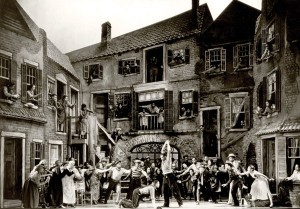The day after the premiere of George Gershwin’s Porgy and Bess at the Colonial Theatre in New York City, a review of the performance appeared in the New York Times that would both articulate the positive aspects of the opera while also aptly summarizing its importance to American music. A portion of the opening paragraph reads:
“An audience which assembled, uncertain whether they should find a heavy operatic work or something more resembling musical comedy, discovered a form of entertainment which stands midway between the two. The immediate response was one of enthusiasm that grew rather than diminished as the evening progressed.” [1]
In other words, Porgy and Bess was an immediate hit because it successfully bridged the gap between the styles of European grand opera and American musical theater in the style of tin-pan alley. By extension, Gershwin was cementing his reputation as the quintessential American composer: a perfect combination of elite artist and regular American. While this synthesis may appear to be a contradiction, there are a number of descriptions in this and other contemporaneous reviews that support this statement.
From the New York Amsterdam News:
“The first act represents George Gershwin’s most serious writing. It is Gershwin struggling for a greater expression, endeavoring to transcend into the world of great music. Contrapuntally speaking, he does. This is evident in the crap game fugue.” [2]
The author (Allen Gilbert) goes on to compare Gershwin to “Brahms, Bach, or Beethoven” for his clarity of theme in symphonic writing, effectively lifting him into a pantheon of greatness. Yet, Gilbert goes on to call the second act a “let down”, describing it as a musical side-show that more resembles a smorgasbord of primitive American music (hot jazz, broadway ballads, negro spirituals) than it does the work of a grand master. He attributes to Gershwin a false quote suggesting that opera is for the “masses” but that they cannot understand it if it’s not dumbed down for them.
But it is the third act that truly shows Gershwin’s greatness, a “gathering together of the parts” that utilizes both ends of the spectrum without compromising on beauty and emotional power. It is with this in mind that the author crowns Gershwin as the “practical idealist”.
While this is a deserving title for the young composer, we can see quite clearly how mind-numbingly kitschy this is, yet another example of American determinism seeking out the next great musical representative for the U.S. of A. This is especially frustrating when we consider the most problematic yet simultaneously inspiring aspect of the work and its initial performances: its nearly all-Black cast. While the New York Times review emphasizes this historic achievement (even including it in the subtitle), the New York Amsterdam review doesn’t even mention it. The first lauds each cast member and the “characterizing detail” given to a normally inhuman and primitive setting; the latter lauds only Gershwin and his ability to humanize to black music without mention of the African Americans involved.
I don’t mean to suggest that Gershwin is responsible for this discrepancy, but it is worth remembering that in the evolving world of American art music in the early 1900s, Porgy and Bess may have been more akin to minstrelsy than to grand opera for many white audiences. Though an article in the Chicago Defender less than a month later claims that “race music is dignified” by Porgy and Bess, this primarily African-American viewpoint doesn’t necessarily reflect a popular perspective of the work. [3] While Gershwin’s “idealistic” genius and his roster of memorable songs is undoubtedly responsible for the works success, it is fascinating to see how the “practical” matters of the performances may have been ignored.
[1] Special to The New York Times. “Gershwin’s Opera Makes Boston Hit.” New York Times (1923-Current File), Oct 01, 1935. http://search.proquest.com/docview/101340968?accountid=351.
[2] Allen, Gilbert. “George Gershwin, Practical Idealist.” The New York Amsterdam News (1922-1938), Nov 16, 1935. http://search.proquest.com/docview/226210087?accountid=351.
[3] McMillan, Alan. “‘Porgy and Bess’ Scores on Broadway.” The Chicago Defender (National Edition) (1921-1967), Oct 19, 1935. http://search.proquest.com/docview/492522466?accountid=351.


Yes. Just, yes.
But seriously, you’re getting at a thorny issue here: Gershwin’s success in “Porgy” can be measured in various ways, and these reviews offer two of them. Formally speaking, is it a “great *American* classic” or a dumbed down hodge-podge of styles and techniques? Socially, is the all-black cast a great leap forward, or is their representation of poor black culture just another instance of stereotyping? I’d be curious to know what Gershwin had to say about some of these questions – I’ll bet he wrote about the opera in letters and probably a few articles as well . . .
Final thought: the library just acquired a book called “Who should sing ‘Old Man River'” by Todd Decker. It’s about “Show Boat,” not Porgy and Bess, but I suspect it offers some possible answers to the questions your post provokes.